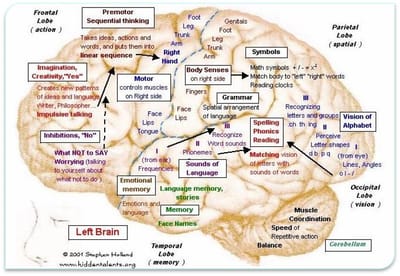The CSCWA now trades as NeuFocus but our goal is still the same:
Change your brain, change your life
Arrowsmith's approach to LEARNING PROBLEMS

We have known for a long time that learning in all parts of the curriculum is a complex task that requires several areas of the brain to be functioning strongly. That's why we measure the strength of 16 brain functions during the assessment. We then prioritize your program to work on the most important ones first. When the person begins their program we know if they are struggling with learning because of difficulties with:
- remembering what a letter or word looks like
- remembering a series of words they have heard
- controlling eye movements that makes the letters on the page appear to swim
- discriminating between the sounds of similar words
- blending sounds together
- understanding the relationship between ideas or concepts
- unable to hold numbers in their mind
- unable to understand non verbal cues
Watch Barbara Arrowsmith, the founder of this program's TedEx talk
Know the symptoms

Motor Symbol Sequencing
The motor symbol sequencing function gives us the ability to learn and produce a written sequence of symbols such as a word, sentence or equation.
Learn More
Symbol Relations
This brain function lets us understand the relationships among two or more ideas.
Learn More
Memory for Auditory Information
This brain function allow us to notice and remember information that we have been told.
Learn More
Broca's Speech Pronunciation
This brain function gives us the ability to pronounce syllables and integrate them into the consistent pronunciation of a word.
Learn More
Symbolic Thinking
This is the ability to develop and maintain plans and strategies through the use of language.
Learn More
Symbol Recognition
This brain function gives us the ability to visually recognise and remember a word or symbol.
Learn More
Non Verbal Thinking
This is the ability to notice and interpret non-verbal information and plan and problem solve non-verbally.
Learn More
Quantitative Sense
This brain function gives us the ability to do mental maths - to hold and add or subtract a number in our mind's 'eye'.
Learn MorePROGRAMS WE OFFER
What does learning need?



Each part of our brain has a very specific function. For a person to be able to read, for example, you need to be able to:
- remember what a letter and whole word looks like (visual memory),
- have the ability to hear and blend sounds into words ( c + a + t = cat) (phonological awareness),
- have a lexical memory (vocabulary) that is able to remember each word,
- have the ability to control the movement of the eyes so they move across the page smoothly (fine muscle control),
- understand what it is the words mean (comprehension), and
- be able to put concepts together to make meaning.
If just one of these brain functions is not working so well then reading becomes very difficult or next to impossible.
The good news is that this can be changed. We now know that our brains are plastic. They can be strengthened so that the functions are strong enough to do the job that is needed of them.
If learning is a problem for you or someone you know:
- Call Joanne on 04 100 451 34
- Contact NeuFocus
- or connect on Facebook
cognitive enhancement

The Symbol Relations brain function simultaneously processes multiple pieces of information. When it is working well it allows us to:
- process concepts across all academic areas,
- understand and grasp what we read and hear,
- gain insight,
- reason logically,
- see connections between ideas,
- understand cause and effect,
- be flexible in our thinking and problem solving,
- make rational and considered decisions,
- grasp the meaning of language deeply and
- reason mathematically.
The gains from strengthening this function are lifelong and generalizable to all aspects of learning that require comprehension and conceptual understanding or reasoning.
In particular, once this area is strengthened to a superior level of functioning students will be able to understand and analyze complex abstract relationships, think critically, and comprehend at a conceptual level. These are critical abilities for living in a rapidly changing and increasingly complex world.
Cognitive enhancement also has a direct positive impact on the success rates of graduates in the science, technology, engineering and mathematics (STEM) fields of study. STEM skills are becoming more important as the use of technology increases. Having a strength in this cognitive function will enable students to perform consistently at a high level when reasoning mathematically, thinking critically and connecting complex ideas. They will be able to synthesize multiple pieces of information so they understand what it means as a whole as well as why it has this meaning.
There are no assessments for this area - instead we have a highly structured process for you to work through. This is the unit that will benefit everyone.
Resources to help
F.A.Q s
What are the criteria for students entering the Arrowsmith Program?
There are also students who just want to do better in life. They enrol in the Cognitive Enhancement cognitive unit - Symbol Relations. This unit strengthens the ability to take mulitple sources of information into account quickly when making a decision, reading or learning. It is a great unit to do just by itself.
Which students are suitable?
We will be happy to answer your questions and, if appropriate, can arrange an assessment for you/your child. Call Joanne on 0410045134.
What age are the students?
Do you have adult students?
Other adults want to strengthen their cognitive ability so they can do exceptionally well in university or to prepare for a promotion at work.
Is the program suitable for people with Autism or Intellectual Disability?
In particular, individuals with learning difficulties who also have Autism Spectrum Disorders (ASD) have benefitted from the Arrowsmith Program. The Program enables these individuals to address the cognitive learning needs which so often accompany autism. Our most recently published research specifically discusses people with autism in the Arrowsmith Program.
Does the program help with attentional disorders?
As an example, if a person has difficulty remembering what the teacher has said to them, it is highly likely they will be seen as 'not paying attention'. If this is complicated by an inability to understand language then your ordinary 10 year old will begin to 'misbehave' in class. It is only the child saying, in the only way they can, 'this situation is not working for me and I don't know what's wrong and I'm worried about it'. Over a period of time, the child might gain the reputation of being unable to concentrate and thus the diagnosis of ADD is considered.
These types of attentional difficulties are specifically identified during the assessment and addressed by the exercises. As the cognitive areas strengthen, the behaviours that indicate they are a problem, fade. Many children on ADD medication are able to come off it after their program has finished because the underlying cause of their symptoms has been addressed.
Do you accept enrolments during the year?
Are beginning students assessed?
Neither the Motor Symbol Sequencing nor the Cognitive Enhancement programs require a full initial assessment - only an evaluation.
Please discuss the assessment process with Joanne on 04100 451 34.
What's the initial assessment for?
Each person's cognitive profile is different, so each person's cognitive program is different, and exactly suitable for them.
Please note the assessment is not used as the basis for determining suitability for the Arrowsmith Program; suitability is determined through discussion with yourself and Joanne (0410045134). Or, you can work it out yourself by doing this questionnaire.
Who does the assessment and analyses the results?
Once we receive the report we will contact you and arrange a meeting to discuss the results with you. You will have every opportunity to ask questions and to decide the right way forward for you or your child.
Can I access the Program online?
When and where can I be assessed?
The assessment comprises tests designed to measure the strength of specific cognitive functions that impact learning. This enables Arrowsmith Program to identify each student’s learning profile of cognitive strengths and weaknesses and provides the basis for designing individual programs for each student.
The assessment is available in onsite and online versions.
Please note the assessment is not used as the basis for determining suitability for the Program. Suitability is determined through the pre-screening discussion between the family and the NeuFocus. You can also work it out yourself by doing this questionnaire.
How long does the Arrowsmith Program take to work?
The majority of students with learning difficulties will require a three-to-four year program of full time attendance to address all of their learning issues fully. If a student is unable to complete the three-to-four year full time program, they achieve benefit each year they are in the program or by participating on a part time basis.
You will notice that the student becomes able to learn independently, effectively and efficiently. This is the essential difference between the Arrowsmith Program and other interventions for learning disorders. The majority of our graduates no longer have problems learning. In fact, research shows that the students, who were previously labelled as having a learning disability and expected to learn at a slow rate, learn at twice the expected rate for an average student per year once they have addressed and strengthened the cognitive areas initially identified as being problematic.
Do students maintain their changes?
How many students are there in each class?
How is attendance at the Program organised?
The Motor Symbol Sequencing program can be done at home. This program develops the ability to write, express thought in speech, read, and spell consistently. Students doing the MSS program work at home and connect with
NeuFocus once per fortnight (at a negotiated time) for monitoring of their progress and adjustment of their program.
Contact
- 7/460 Roberts Road, Subiaco WA, Australia
- +61-410045134 - The Cognitive Strengthening Centre
- hello@neufocus.com.au
- 8.00 - 5.00pm week days
Events
Past Events
| Title | Date | Day | Location | Tickets |
|---|---|---|---|---|
| Barbara Arrowsmith online | 30 Jun 2021 | Wednesday | Online Event | Closed |
| Building a Better Brain for Success: Neuroplasticity and Learning | 24 Mar 2021 | Wednesday | Online Event | |
| https://at-home.arrowsmithprogram.com/virtual-world-tour-2021-feb | 17 Feb 2021 | Wednesday | Online Event | Closed |
| Virtual Tour by Barbara Arrowsmith Young | 22 Jul 2020 | Wednesday | Online Event | Closed |
| Barbara Arrowsmith presents in Perth | 11 Feb 2020 | Tuesday | The Octagon Theatre, University of WA | Closed |
| Open night at Fremantle Education Centre Arrowsmith Program | 22 Jan 2019 | Tuesday | Corner Cantonment and Parry Street Fremantle | Closed |
| Open night at Fremantle Education Centre Arrowsmith Program | 21 Nov 2018 | Wednesday | Fremantle Education Centre | Closed |
| Debbie Gilmore speaks | 15 Aug 2018 | Wednesday | Fremantle Education Centre | Closed |
| Open night at Fremantle Education Centre Arrowsmith Program | 03 May 2018 | Thursday | Corner Parry and Cantonment Streets, Fremantle | Closed |
Privacy Policy

Information about you is only obtained if you supply it to us and is only used for our internal purposes including contacting you and answering your questions. The provision of personal information to us through our website is at your sole discretion and by providing any such information you are consenting to its collection and use in accordance with this Privacy Policy. All personal information we collect, use or disclose on or through this website is for the sole purpose of providing information about our services to you.
We treat visitor information as confidential and it will not be disclosed to anyone without consent except as required by law, or in accordance with this privacy statement or as permitted pursuant to the Privacy Act 1988. We do not sell visitor information provided to us or give or sell confidential information to any third party.
Our web hosting service may use soft ware that receives and records internet protocol addresses. Whilst we make reasonable efforts to avoid linkage of these addresses to individuals visiting our site, linking may occur and may be required in cases of abuse.
Personal information submitted by a person can be accessed upon request. We will require provision of proof that the requesting person is the same person who has provided the personal information. This is for the purpose of verification and correction of said personal information. Access to the personal information will only be provided if:
i) It does not and will not effect or reveal any information which is confidential to any other party, or the personal information of a person or persons other than the requestor, and
ii) Providing access to such information will not effect confidentiality in respect of any matter we are entitled to and/or obliged to maintain as confidential.
This site may contain hypertext links to other sites. We are not responsible for the privacy practices or content of such websites.
Should you have any matters that you would like to discuss regarding this Privacy Policy please contact Joanne at hello@neufocus.com.au
About me

Roll on a few years and my children were old enough for me to return to the workforce and I decided to become an early years teacher so I could identify and provide early intervention for those children who were showing the early signs of learning difficulties. The aim was to refer them for speech pathology and occupational therapy. I was a bit shocked when I discovered the very low level of understanding of learning and learning problems amongst teachers. Parents were being told ‘he’s a boy’, ‘he’ll grow out of it’, ‘he’s a second child’, ‘girls always struggle with maths' when these things are very untrue. Thinking it was my own lack of experience in the field, that there was something I didn’t understand, I enrolled in a Master’s degree to find out some more, and found that even at that level of study there was very little teaching about or understanding of the sorts of developmental issues that indicated a learning problem was imminent for the child. It seemed that the education system is only set up for those people who don’t have a problem with learning. Yet there are credible estimates that 15% of the population do have such a problem.
Then I saw an advertisement for a position as an Arrowsmith Teacher. I hadn’t heard of the Arrowsmith program before and was more than a little sceptical about it. It seemed to promise that learning disorders could be overcome! Parents have been promised this before only to find little or no change in their child’s learning and I didn’t want to be part of an organisation that promised but did not deliver. In addition, the claims of fundamental change being made to the person’s learning capacity were entirely against everything I had ever learned. I was, however, intrigued and investigated further. The research that had been done was really compelling and I was amazed by the seemingly miraculous changes in people’s lives that had occurred. This was something I wanted to know more about!
I applied for the position, was selected and trained as an Arrowsmith Teacher. Finally, I had found something I could dedicate myself to. Initially it was the social justice aspect of the program that appealed to me. I believe that all students have a right to receive the education they need to become independent in our literate and numerate society and this program maximises the chances of doing that for people with learning disorders.
As I’ve continued, however, I have become very aware of the pain that learning disorders cause. Children think they are ‘dumb’ because they can’t learn and might withdraw or become ‘behaviourally challenged’. Adolescents develop mental health issues because they struggle so much at school and are told – ‘just concentrate a bit more/ try harder’ as though it is their fault that they cannot learn, not the fault of the teacher who cannot teach them. Adults have missed out on reaching their potential because they are either not as literate and numerate as they need to be, or their executive functioning is not well enough developed for them to plan, manage themselves and understand the workplace.
All of these things are now unnecessary, because now we know what to do to help people with these problems.
The Arrowsmith Program helps people strengthen their cognitive skills and overcome their learning disorders so they can start to participate fully in our literate and numerate society. It is a privilege to facilitate it for people and a delight to watch them progress as their brain changes to make them more capable, stronger learners. It is incredible to me to walk beside someone and watch as they develop their underlying cognitive skills and become more aware of the world, gain independence and enable their potential. I love getting the late night texts from parents to tell me their teenagers have just told them that they got 73% in science and 64% in maths (rather than 15% and 22%). 'he's getting better each day. :-) Yay.' Surely, as adults in our community, this is what we want for the next generation??
I invite you to contact me to talk about whether this program is suitable for you or someone you love.
For more information or a no obligation chat:
- Call Joanne on 04 100 451 34
- Contact NeuFocus
- Connect on facebook
NeuFocus acknowledges the First Nations people of this land and pays our respects to their culture, people and Elders past, present and future.


